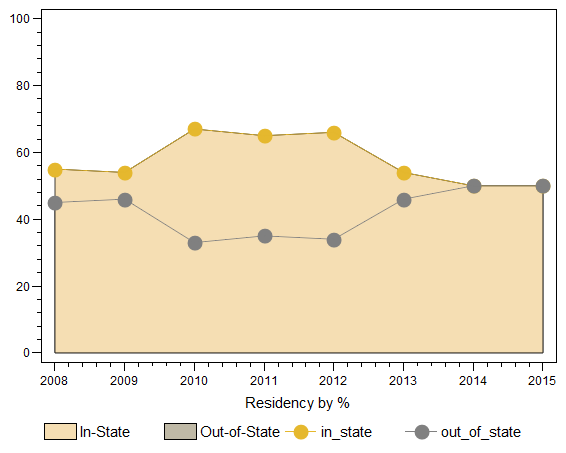- Home
- /
- Programming
- /
- Graphics
- /
- How to show a connecting line in an area-filled overlay plot?
- RSS Feed
- Mark Topic as New
- Mark Topic as Read
- Float this Topic for Current User
- Bookmark
- Subscribe
- Mute
- Printer Friendly Page
- Mark as New
- Bookmark
- Subscribe
- Mute
- RSS Feed
- Permalink
- Report Inappropriate Content
I used proc gplot to produce the graph below. As the out-of-state area (represented by gray dots) was smaller than the in-state area and was specified as the second layer, the line connecting the gray dots were somehow disappeared. Do you know how to get the connecting line displayed in this particular case? Thank you very much.
--------------------------------------------------------------------------------------
Below are the codes I used:
goptions /*reset=all*/ hsize=15cm vsize=12cm;
pattern1 color=wheat;
pattern2 color=brpk;
symbol1 interpol=join value=dot h=1.5 color=bioy;
symbol2 interpol=join value=dot h=1.5 color=gray;
legend1 label=none value=(color=black height=1.5 'In-State' 'Out-of-State');
axis1 offset=(2,2)
label=(height=1.5 'Residency by %')
major=(height=2)
minor=(height=1);
axis2 order=(0 to 100 by 20) offset=(0,0)
label=none
major=(height=2)
minor=(height=1);
title1;
proc gplot data=test4c;
plot in_state*acad_year out_of_state*acad_year
/ line
overlay
haxis=axis1
hminor=4
vaxis=axis2
vminor=1
caxis=black
areas=2
legend=legend1
;run; quit;

- Mark as New
- Bookmark
- Subscribe
- Mute
- RSS Feed
- Permalink
- Report Inappropriate Content
What happens if you flip the PATTERN definitions, SYMBOL definitions, and the order of the pairs on the PLOT statement?
- Mark as New
- Bookmark
- Subscribe
- Mute
- RSS Feed
- Permalink
- Report Inappropriate Content
Thank you Dan. I would not want to do it as I wanted to keep it in the same order as the data table above (in-state, and then out-of-state). (This order is the standard used in my office.) Is there any way to work around it? Thank you.
- Mark as New
- Bookmark
- Subscribe
- Mute
- RSS Feed
- Permalink
- Report Inappropriate Content
I can't run this to make sure you get the same output, but give this a try and see what you get:
proc sgplot data=test4c;
yaxis label="Residency by %";
xaxis display=(nolabel) offsetmin=0 offsetmax=0;
band x=acad_year upper=in_state lower=0 / fillattrs=(color=wheat) transparency=0.5
name="in" legendlabel="In-State";
band x=acad_year upper=out-of-state lower=0 / fillattrs=(color=wheat) transparency=0.5
name="out" legendlabel="Out-of-State";
series x=x=acad_year y=in_state / markers lineattrs=(color=bioy);
series x=x=acad_year y=out_of_state / markers lineattrs=(color=gray);
keylegend "in" "out";
run;
- Mark as New
- Bookmark
- Subscribe
- Mute
- RSS Feed
- Permalink
- Report Inappropriate Content
Thank you Dan. It worked!
- Mark as New
- Bookmark
- Subscribe
- Mute
- RSS Feed
- Permalink
- Report Inappropriate Content
Here's 1 way to do it with gplot. Just add an extra overlay of the same 2 things you're plotting, and the'll be on top (the first time plots the areas, and the 2nd time plots the lines)...
data test4c;
input acad_year in_state out_of_state;
datalines;
2008 55 45
2009 54 46
2010 67 33
2011 65 35
2012 66 34
2013 54 46
2014 50 50
2015 50 50
;
run;
goptions /*reset=all*/ hsize=15cm vsize=12cm;
pattern1 color=wheat;
pattern2 color=brpk;
symbol1 interpol=join value=none color=bioy;
symbol2 interpol=join value=none color=gray;
symbol3 interpol=join line=1 value=dot h=1.5 color=bioy;
symbol4 interpol=join line=1 value=dot h=1.5 color=gray;
legend1 label=none value=(color=black height=1.5 'In-State' 'Out-of-State');
axis1 offset=(2,2)
label=(height=1.5 'Residency by %')
major=(height=2)
minor=(height=1 number=4);
axis2 order=(0 to 100 by 20) offset=(0,0)
label=none
major=(height=2)
minor=(height=1 number=4);
title1;
goptions device=actximg;
proc gplot data=test4c;
plot in_state*acad_year=1 out_of_state*acad_year=2
in_state*acad_year=3 out_of_state*acad_year=4
/ overlay areas=2
haxis=axis1 vaxis=axis2
caxis=black legend=legend1;
run; quit;

April 27 – 30 | Gaylord Texan | Grapevine, Texas
Registration is open
Walk in ready to learn. Walk out ready to deliver. This is the data and AI conference you can't afford to miss.
Register now and lock in 2025 pricing—just $495!
Learn how use the CAT functions in SAS to join values from multiple variables into a single value.
Find more tutorials on the SAS Users YouTube channel.
SAS Training: Just a Click Away
Ready to level-up your skills? Choose your own adventure.



